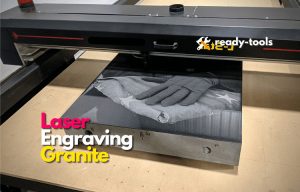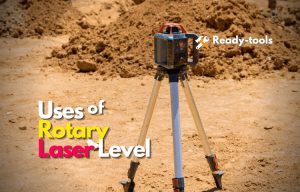Engraving is a way of permanently marking precious and valued materials. The art of engraving has been around for thousands of years, the biggest example being the stone tablets from ancient Egypt. However, engraving text, data, and complex designs can be challenging as they require extreme precision. Fortunately, modern tools have paved the way for ease, consistency, and accuracy in the field of engraving.
Nowadays, people use two engraving methods for various materials, i.e., hand engraving and machine engraving. In this regard, different types of engravers are used depending on the project requirements. However, some people still prefer the authentic handheld engraver over the automatic laser engraving for its elegant burnt finish. Therefore, this article will discuss everything there is to know about laser engraving vs hand engraving so that you can choose the best option for your project.
What is Hand Engraving?

Hand engraving uses different electrical tools like drills, hardened steel bits, sandpaper, and rotary tools to engrave text and designs on different materials. Hand engraving techniques have also evolved over the past few years, like laser engraving. For instance, professionals no longer have to use blades or sickles to engrave. Instead, modern machine tools are used to cut and etch even hard materials like stones, metals, and wood.
Advantages of Hand Engraving:
Although hand engraving is an ancient art, most people still find it more effective than laser engraving. There are many advantages to hand engraving that still make it a popular choice for artists to use today. Here are some of its major advantages:
- The main benefit of hand engraving is that it gives you control over the depth of the engraving. For instance, some designs require a combination of deep and shallow grooves, and hand engraving techniques are the only way to achieve such perfection.
- Laser engravers are suitable for simple designs and fonts but ineffective for complex designs. For example, if your design has two intersecting lines with different depths, only a hand engraving tool can help you generate such patterns. In other words, hand engraving allows you to create extremely detailed designs without any software complications.
- Hand engraved materials are more durable than laser engraving. The main reason is that hand engraving forms the designs by chipping away tiny bits of material without damaging the material’s integrity.
Disadvantages of Hand Engraving:
Hand engraving is preferred for most; however, it has several disadvantages that make it unsuitable for modern projects. For instance, it requires a lot of experience in the field before you can create professional designs. Here are some of the disadvantages of hand engraving:
- Hand engraving is a time-consuming task that often requires several days to complete just a portion of your project. On the other hand, a laser engraver can complete even the most complex projects in under 30 minutes.
- Secondly, there is a lot of room for human error and mistakes in a hand-engraved project. Moreover, the only way to correct the mistake is by starting again.
- Hand engraving isn’t a beginner-friendly task, i.e., it requires years of experience before you can set up your workshop. On the contrary, a laser engraving machine automatically completes the task if you have the correct settings and design.
Which Materials are Ideal for Hand Stamping?
Hand engraving is rather a small field with very limited materials. The engraving material must be of the perfect consistency and hardness for hand engraving. The too soft material will break under pressure, whereas the too hard material won’t engrave at all. Here are some of the most common materials used for hand engraving:
Aluminum:
Aluminum is by far the most commonly used material for hand engraving projects. It is a soft material that you can engrave, etch, or bend without heating it first. Moreover, this material gives the upper hand to hand engraving over laser engraving, as a CO2 laser can overheat the material.
Copper:
Copper is another soft material that you can use for hand engraving. It only requires a little heat to make it malleable for different projects. The results are highly durable and long-lasting when comparing the hand-etched vs engraved copper results. However, there is always a risk of rapid tarnishing in such projects.
Other Suitable Materials:
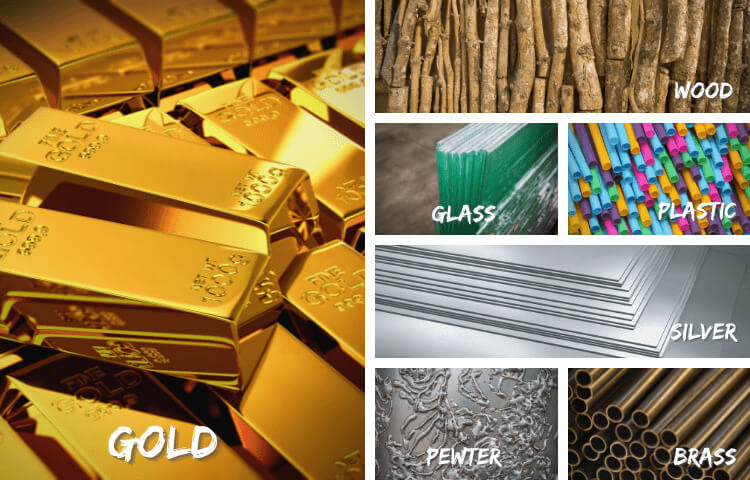
- Gold
- Silver
- Plastic
- Wood
- Glass
- Pewter
- Brass
Hand Engraving Methods:
Engraving a material by hand is very similar to writing a love letter. The effort, time, and love that goes into such projects not only makes the product durable but also valuable. There’s nothing quite like the satisfaction of creating something with your own two hands. Initially, hand engraving was done by non-electrical tools like chisels, gravers, and gouges.
However, the invention of rotary tools, multi-tools, and drills added a lot of ease to the field. Nowadays, a single multi-tool drill can be used for polishing, engraving, grinding, sawing, and drilling almost any material. There are two ways to engrave a material by hand:
- Using hand tools
- Using rotary tools
Hand Tools:
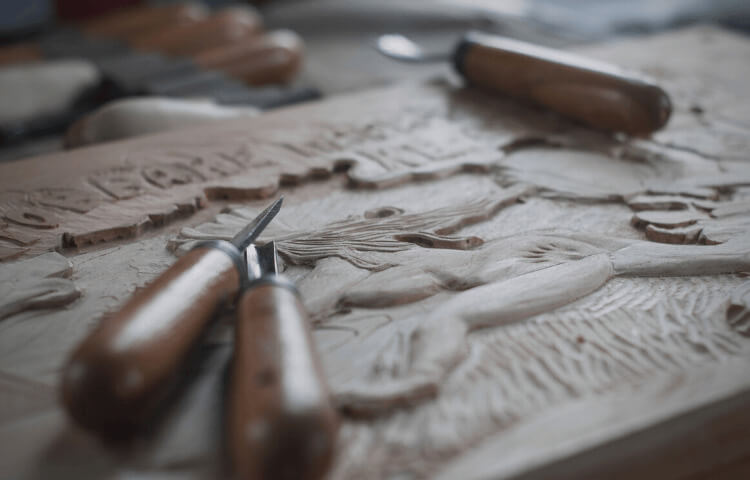
Although modern tools make it a lot easier to engrave almost any material by hand, some people still discard all modern means and stick to conventional engraving techniques. This method is very time-consuming and requires a lot of precision. However, the final product is far more valuable than any machine engraved design.
Hand tools usually consist of a hammer, chisels, gravers, screwdrivers, and blades. Basically, any gadget that doesn’t require electric power and solely depends on the power of your hand comes in the category of hand tools. However, this type of project requires great expertise and patience. So, it is up to you to decide whether you are up for the job or not.
Rotary Tools:

Rotary tools are modern equipment that makes any job very easy for professionals. You don’t need to spend hours of manual labor polishing, grinding, and engraving the material. Moreover, the gentle rotary action is suitable for working on softer materials like glass, plastic, and acrylics. So, hand engraving with a rotary tool can boost your area of expertise.
Similarly, rotary tools cut off the time required for engraving as opposed to chiseling by hand. However, you must have the right set of drill bits made out of tungsten, hardened steel, carbide, and diamond tips to work on different materials. In my opinion, hand engraving with a rotary tool is the perfect option for most businesses and DIYers these days.
What is Laser Engraving?

Laser engraving is a type of engraving in which the topmost layer of material is melted or vaporized using a powerful laser beam. The small diameter of the laser allows the user to make microscopic changes to the design without any additional tools. Moreover, a single laser engraver is suitable for working on different materials without altering the device. In short, it is the latest technology of engraving generally used in most projects.
Advantages of Laser Engraving:
Laser engraving is an automatic technique that uses instructions from computer software to adjust its speed, power, and laser path. So, there is very little room for mistakes in the design, and the final product is perfect every time.
- Laser engraving is an automatic process that doesn’t require as much experience as hand engraving.
- The laser beam has a small diameter making it possible to engrave micro patterns in your designs.
- Laser engraving isn’t as time-consuming as hand engraving, and you can complete almost any project in under 30 minutes.
- Laser engraver supports far more materials for engraving than hand engraving.
Disadvantages of Laser Engraving:
Like any technology in the world, laser engraver also has a few disadvantages. However, they are not as serious as hand engraving. So, feel free to shift your business to the latest laser technology.
- Different types of laser engravers are suitable for various materials. For instance, a CO2 laser is suitable for soft materials like wood, plastic, leather, paper, and food. On the other hand, you need a fiber laser to engrave, etch, and cut metals.
- You must learn graphic designing and understand the color dynamics before you can work with a laser engraver.
Which Materials are Ideal for Laser Engraving?
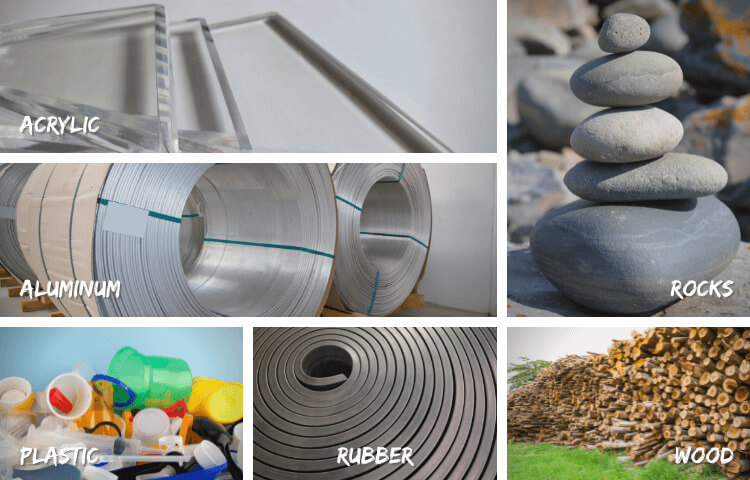
The major benefit of laser technology is that it supports a lot more materials than a typical hand engraver. For instance, you can use a single CO2 laser to work on wood, plastic, rubber, leather, acrylic, food, rocks, and aluminum. Similarly, metal materials for laser engraving require a more powerful fiber laser or high-end CO2 laser. In short, there is no limitation in terms of material when working with a laser engraver.
Laser Engraving vs Hand Engraving: What’s the Difference?
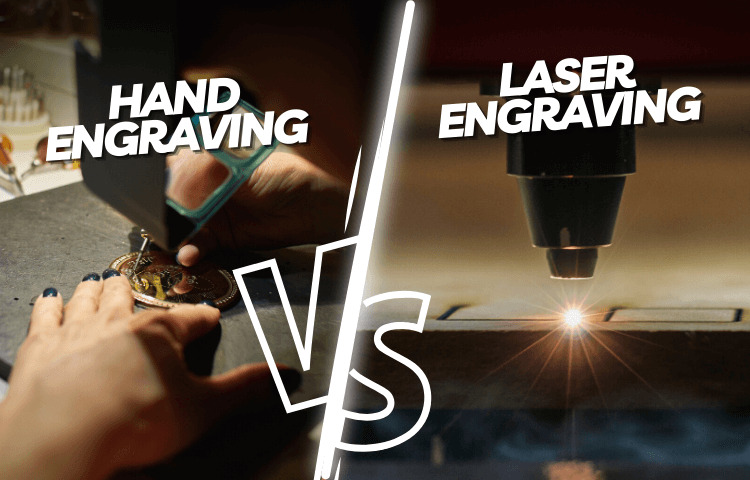
| Hand Engraving | Laser Engraving |
|---|---|
| Hand engraving requires chiseling by hand or a rotary tool to engrave the materials. | Laser engraving uses a powerful laser beam to melt the topmost layer of the material to etch, cut, and engrave. |
| Hand engraving is suitable for metals, plastic, and wood only. | Laser or machine engraving is suitable for most materials, including wood, plastic, paper, rubber, leather, metals, rocks, etc. |
| Hand engraving requires patience, practice, and experience. | Laser engraving is an automatic technique that doesn’t require much experience. |
| Hand engraving a material can take anywhere from several hours to a few days. | Laser can quickly melt any material, producing the final product in under 30 minutes. |
| There is not much demand in the market for hand engraving, especially in the industrial sector. | Laser engraving is a rapidly growing industry with regular public and industrial sector customers. |
Frequently Asked Questions:
Can you laser-cut sterling silver?
Yes, you can use a high-end CO2 laser or an industrial fiber laser to cut, etch, and engrave sterling silver and other metals, including aluminum, copper, and gold.
How does engraving work?
Engraving is a concept of chipping away the topmost layer of the materials to form grooves in various patterns. These grooves deepen to form a permanent marking or engraving, and the material is cut when you further deepen the engraving.
How to engrave stone by hand?
Cover the stone with a vinyl sheet or transparent tape.
Use a sharp blade or tool to cut the pattern on the rock.
Carefully remove the marked portion without damaging the extra vinyl.
Start chiseling with a rotary tool and a suitable drill bit.
Gradually change the drill bits from small to large while tracing the design.
Finally, polish the engraving with sandpaper to remove any extra shipping.
Conclusion:
Engraving is an ancient concept of permanently marking different hard and soft materials to produce texts and designs. The first use of engraving can be seen in ancient Egyptian and other cultures. However, modern tools make it easier and quicker to engrave different materials.
Nowadays, you can use a laser engraver or a rotary tool for your engraving projects. The problem is people are often confused between the two methods. Therefore, this article provides all the information that you need to choose between laser engraving vs. hand engraving for your projects.

